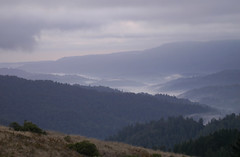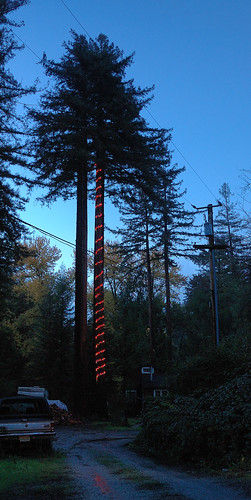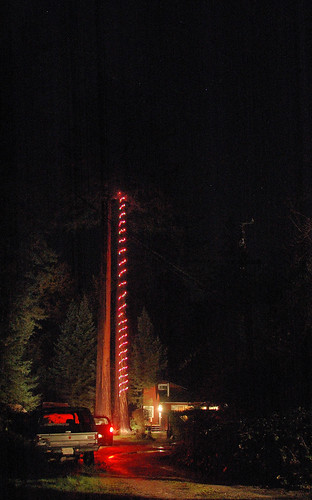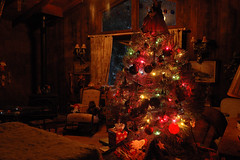(No, not "idle bridge" -- that would be this one .)
 In Henry Cowell Redwoods State Park: part of the railbed of the Santa Cruz, Big Trees & Pacific Railway Company.
In Henry Cowell Redwoods State Park: part of the railbed of the Santa Cruz, Big Trees & Pacific Railway Company. There was a very nice, short article about our San Lorenzo River valley in the San Jose Mercury early this summer. It was about a feature that our valley still has that is disappearing from other rivers across America: the swimmin' hole, unfenced, unregulated, un-chlorinated, and probably a little unsanitary, too.
The San Lorenzo River is very short; it runs from the crest of the Santa Cruz Mountains southward to the city of Santa Cruz on Monterey Bay, a distance of less than twenty miles. The whole valley, in fact, can be seen in this photo from a recent SherWords post, from its origin near the bottom of that frame to its outlet in the mid-distance haze. (The smoke plume was from the "Lockheed" wildfire of last month.) Its course runs through a magnificent forest of sequoia sempervirens (coast redwoods) and wends its way through several small towns. A few of those towns dam the stream during the summer to make swimming places for kids (and others) and, especially in its last few miles, there are a number of natural pooling places that require no dammed assistance.
One of those natural pools is in Henry Cowell State Park just south of Felton. (That park was itself a recent topic here in a different context. ) It is in an idyllic place in the park -- if you don't think a railroad excludes the entire concept of "idyll" -- where the river begins its winding path through its final steep canyon to the sea. It is under a hundred-year-old railroad bridge, a bridge that now carries only tourist trains operated twice a day for round trips to the Santa Cruz beach and boardwalk by the Roaring Camp folks.
Shortly after I was finished with summer school in August, I took an early-morning walk with my old Nikon and tripod down the railroad tracks to the bridge. Fog from Monterey Bay still hung at about treetop level in the canyon, lending a muted, diffused light to the redwoods and the forest floor.
 The bridge itself posed gracefully for its portraits...
The bridge itself posed gracefully for its portraits... ... and I clambered down for a view into the morning's foggy glare downstream:
... and I clambered down for a view into the morning's foggy glare downstream: I resolved to come back at a time when the excursion train was scheduled to cross the bridge, and, after checking the schedule, returned two days later at about 10:30am (after having taken a quick trip to the mountains' crest to snap the above-referenced photo of smoke from the wildfire on Ben Lomond Mountain.)
I resolved to come back at a time when the excursion train was scheduled to cross the bridge, and, after checking the schedule, returned two days later at about 10:30am (after having taken a quick trip to the mountains' crest to snap the above-referenced photo of smoke from the wildfire on Ben Lomond Mountain.)When I reached the bridge and set up my tripod a little downstream from it, a trio of young girls was already there, enjoying the swimmin' hole under the bridge, taking turns swinging on the long, leisurely rope dangling from the bridge to the water. The photos below, if seen only here, show neither rope nor young girls. If you click on any of the next three photos, though, you should be able to see the long rope near the right-hand bridge pier.
 When the train arrived, the girls scuttled, giggling, up the river bank into the woods, but...
When the train arrived, the girls scuttled, giggling, up the river bank into the woods, but... ... even before the train had completely passed over the bridge, they were back.
... even before the train had completely passed over the bridge, they were back.
This confluence of things from a different time -- an old railroad bridge, a languid river's swimming spot, a swinging rope's enthrallment -- led me to indulge myself in a bit of Photoshop cuteness that I don't want to let myself do very much. I altered one of my grade-level photos of the bridge to include a different destination on its far side:
 A bridge too far.
A bridge too far.(You really have to click on the above image to see it larger to get all that I want you to see. Please?)
I think of the strolling figure on the other side, walking with measured strides farther on down the track, as my Dad, who was deeply intrigued by trains and especially their railbeds' courses throughout his life. I am not on the bridge yet, nor (I hope) will be any time soon -- but I can sure see it from here. One of my sons has the good grace to be behind me, out of sight in this picture. The other has broken the rules, has impetuously rushed across the bridge ahead of me, and is already out of sight around the tracks' curve, as was always his way.
As I said, I don't want to let myself do this very much. But there was something about the old bridge, and the morning's fog, and the redwood forest that let me do it this once.

























